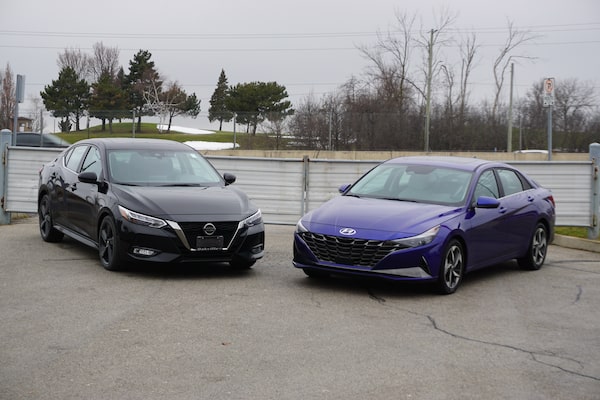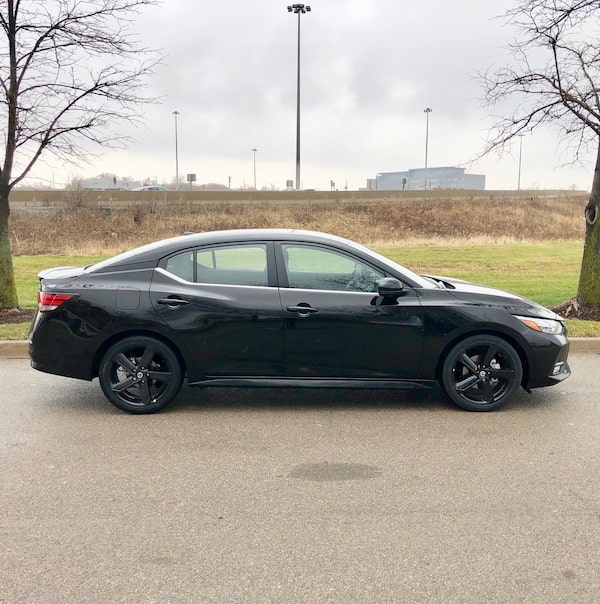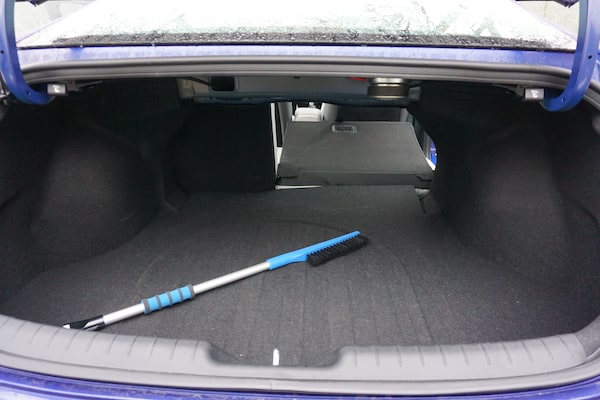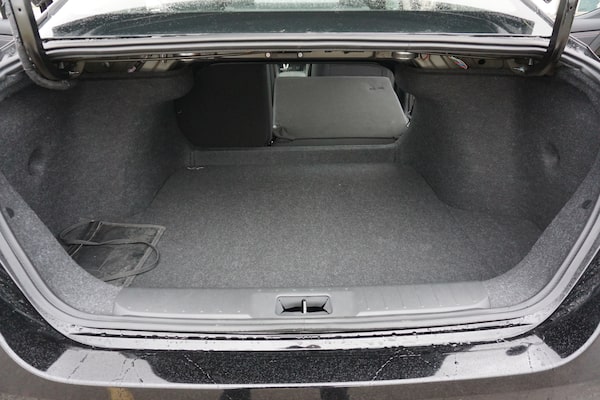
The 2021 Nissan Sentra, left and 2021 Hyundai Elantra, both finalists for the 2021 North American Car of the Year.Photography by Jeremy Sinek
The compact-car category may be down, but it’s not out. While some players have withdrawn from the competition, those still in the game show no sign of losing their drive and determination. To wit: These two working-class compact sedans occupied two of the three finalist positions in the 2021 North American Car of the Year awards – alongside a luxury sedan that sells for about $70,000. And in the final vote, the Hyundai (base price: $17,899) came out on top.
Did the jurors get it right? I spent a day driving back-to-back loops in an Elantra Ultimate and a Sentra SR. The SR is a slightly sportier version of the Sentra, though its 149-horsepower, two-litre engine is the same as in any other Sentra. Elantra will show its own sporty side with an upcoming 201-horsepower, N-Line model, but the Ultimate has the same 147-horsepower, two-litre engine as its lower-trim, garden-variety stablemates.
Looks


The Sentra's 'floating' C-pillar look gets a slight edge over the Elantra's slightly fussy design.Jeremy sinek/The Globe and Mail
Both are wider and lower than their predecessors and make striking visual statements. Hyundai calls its design a four-door coupe look, but while undeniably eye-grabbing, it’s marred by fussy details like the black plastic in the C-pillars just behind the rear doors. We prefer the Nissan’s “floating” C-post pillar look, though the effect is lost if you choose the black roof that’s available with certain colours. LED headlights are available on both but more widely so on the Sentra, which also can be had with 18-inch wheels – one inch bigger than Elantra’s biggest.
Interior

The Sentra features a relentlessly functional cockpit.
Both cars are among the roomiest in their segment. On first glance, you may think they’re compacts, but based on interior volumes, the U.S. Environmental Protection Agency classifies them as mid-sizers. Rear-seat room shouldn’t be an issue in either, though a third passenger in the back might appreciate the Sentra’s extra 75 millimetres of hip room. The Nissan also has a smidgen more overall legroom, but there’s a tad more rear headroom in the Hyundai.
Front-seat occupants, meanwhile, are presented with two very different environments. Available only in black, the Sentra’s cockpit is relentlessly functional, with crisply calibrated analog gauges, user-friendly temperature and ventilation controls grouped closely with either a seven- or eight-inch freestanding touch screen, and ample hard-button redundancy for screen-phobic Luddites. Too bad that you can’t get eight-way driver’s-seat adjustment on the Sentra; it’s only six-way (not counting lumbar) at every trim level, and the range of adjustment didn’t work well for me. Still, a special mention here for Nissan’s attention to an issue that’s often overlooked: lots of face-level air vents, all individually adjustable for aim and flow.


The Elantra's Ultimate Tech trim level features a unified set of cockpit screens similar to that of recent Mercedes models.
Hyundai went radical with the Elantra’s interior, especially in the fully loaded Ultimate Tech with its 10.25-inch main screen angled toward the driver, paired with a same-size gauge-cluster screen, both side-by-side under a single pane as in recent Mercedes models. (Other Elantra trims have an eight-inch touch screen and a conventional, albeit somewhat stylized, analog gauge cluster.) Like the Sentra, the Elantra doesn’t rely too heavily on screens for basic functions, although for some reason the Ultimate Tech trim loses the radio-station-tuning knob that lesser trims do have.
Either way, it’s all very driver-centric, reinforced by a railing-like buttress (Hyundai calls it a “cornering grab-handle”) that curves down from the dashboard to the centre console, just to the left of the passenger seat. Still, a low dashboard helps prevent claustrophobia, especially with the light-grey interior available on the Ultimate trim; slender pillars and a well-placed door mirror ensure superb visibility. Although an eight-way power driver’s seat is exclusive to the top trim, the base six-way seat was more hospitable, for this driver at least, than the Sentra’s.
Performance
Both are propelled by 2.0-litre, four-cylinder, naturally aspirated engines rated just shy of 150 horsepower, but the Sentra claims significantly more torque (146 lb.-ft.) than the Elantra (132). Does that make the Sentra faster? Not necessarily; the Elantra is more than 100 kilograms lighter. Although we had no opportunity for instrumented performance testing, we predict that when the hammer’s down and the stopwatch stops, it’ll be a tie – say zero to 100 km/h in the mid-nine-second range.
Both engines are civil even when exercising hard, but in routine driving, the Elantra is a little better at keeping the engine speed down, minimizing the seemingly random rpm surges typical of continuously variable transmissions, which both cars employ. There’s less wind and tire roar in the Elantra, too. Both cars have well-sorted suspensions that ride well, and any slight advantage to the Elantra on the day may be down to tire differences –– the Elantra on 225/45R17 winter rubber, the Sentra SR on more aggressive 215/45R18 all-seasons. No surprise that the Sentra steered and gripped more assertively when driven friskily; yet there’s something deeply satisfying about the Elantraʼs exceptionally direct, fluent and linear response to the helm – a sweet surprise, given that the Ultimate trim has no obviously sporty pretensions. (That’ll be the N-Line’s job.)
Technology
How much time do you have? Both cars are well endowed with assisted-driving (AD) mod cons, including, even on the base models, forward automatic emergency braking, lane-departure warning, high-beam assist and driver-alertness monitoring. One key difference is that the Sentra includes all of the above even on the base manual-transmission trim (hence the higher base price), whereas on the Elantra, they’re packaged with the $1,900 automatic transmission. Both manual-transmission base models have a back-up camera, but only the Elantra automatic includes active lane-keeping and lane-following assist, while only the Sentra gives you blind-spot warning and rear automatic emergency braking.
Moving up to their respective mid-grade trims, on the Elantra Preferred, safe-exit warning, plus blind-spot and rear cross-traffic collision-avoidance assist are included; and on the Sentra SV, adaptive cruise control.
On the Elantra, you need the top-trim Ultimate to get adaptive cruise, with a more sophisticated version of forward automatic emergency braking thrown in. Moving up to the Sentra SR doesn’t add any more AD skills, but loading up on the Premium package includes a bird’s-eye-view camera. Elantra’s Tech package adds its own AD features that the Sentra doesn’t offer: highway driving assist (which includes automatic slowdown for curves) and reverse parking-collision-avoidance assist.
On the infotainment side, most of the expecteds are available, but only the Elantra offers wireless phone charging, and neither can be had with a WiFi hot spot. SiriusXM comes in at the middle trim in each case.
Cargo


The rear seat pass-through on the Elantra, above, appears to be slightly more accomodating than the Sentra's.
Trunk volumes are near-enough a wash – 405 litres for the Sentra and 402 for the Elantra. The Elantra’s folded-seats pass-through, however, looks a little more accommodating for bulky objects.
Verdict
The Nissan Sentra is an excellent modern compact sedan. The Hyundai Elantra is an even better one. They both deserved to be Car of the Year finalists, and the Elantra deserved to win.
2021 Hyundai Elantra
- Base price/as tested: $17,899/$28,299
- Engine: 2.0-litre, four-cylinder
- Transmission/drive: Six-speed manual or CVT automatic/front-wheel drive
- Fuel consumption (litres/100 kilometres): 6MT: 9.1 city/6.3 hwy; CVT: 7.1 city/5.5 hwy
- Alternatives: Honda Civic, Kia Forte, Mazda3, Nissan Sentra, Subaru Impreza, Toyota Corolla, VW Jetta
2021 Nissan Sentra
- Base price/as tested: $19,198/$24,198
- Engine: 2.0-litre, four-cylinder
- Transmission/drive: Six-speed manual or CVT automatic/front-wheel drive
- Fuel consumption (litres/100 kilometres): 6MT: 9.3 city/6.3 hwy; CVT: 8.0 city/6.0 hwy
- Alternatives: Honda Civic, Hyundai Elantra, Kia Forte, Mazda3, Subaru Impreza, Toyota Corolla, VW Jetta
Shopping for a new car? Check out the new Globe Drive Build and Price Tool to see the latest discounts, rebates and rates on new cars, trucks and SUVs. Click here to get your price.
Stay on top of all our Drive stories. We have a Drive newsletter covering car reviews, innovative new cars and the ups and downs of everyday driving. Sign up today.